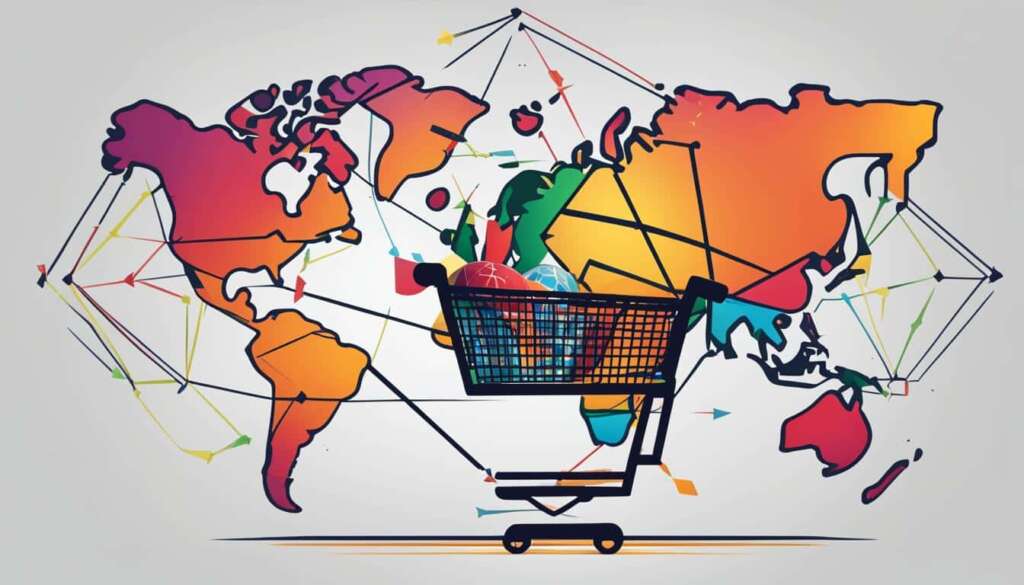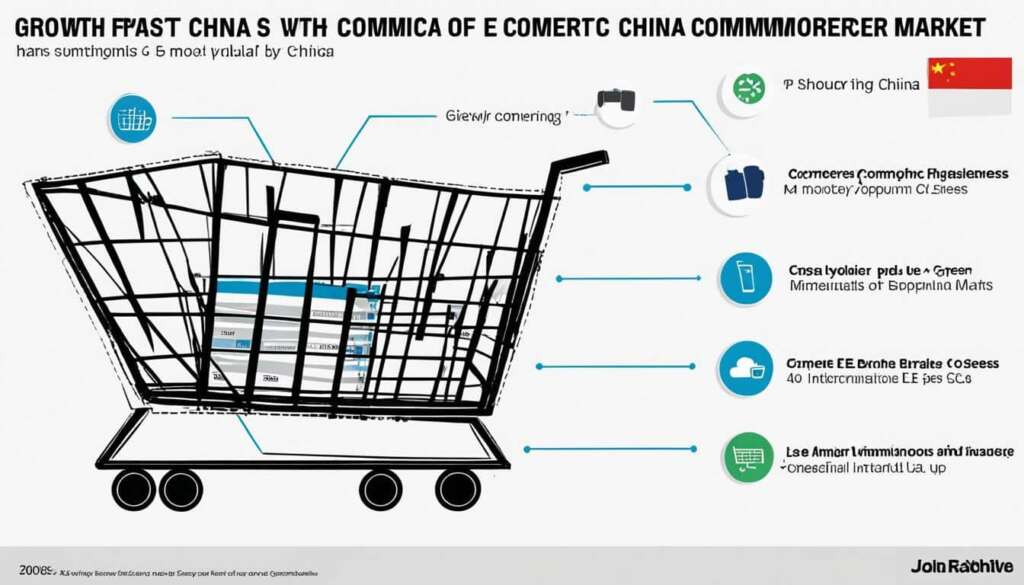Table of Contents
E-commerce is not just a luxury, but a necessity for businesses. Global e-commerce refers to selling products or services across geopolitical borders from a company’s country of origin. It offers several advantages, including easier expansion into foreign markets, shorter B2B sales cycles, and lower barriers to entry. The global e-commerce market is expected to reach $6.3 trillion in 2023, with an 8.9% increase in growth. China leads in global e-commerce sales, followed by the US and the UK. Latin America, Singapore, and the US are also experiencing significant growth in e-commerce. Inflation and supply chain disruptions, influenced by the pandemic, are important factors to consider when expanding into the global e-commerce market.
When it comes to tapping into international market opportunities, businesses must devise effective strategies that cater to the unique challenges and opportunities of the global e-commerce landscape. This article will explore the key insights, top target markets, success strategies, emerging trends, and global e-commerce conclusions for businesses aiming to thrive in the global marketplace. Whether you’re a small startup or an established multinational brand, this article will provide you with valuable insights and actionable strategies to unlock your full potential in the global e-commerce space.
The Top Global E-Commerce Markets to Target
When expanding globally, it is crucial to identify high-potential target markets. The top global e-commerce markets to prioritize include the United States, the United Kingdom, China, India, and Germany. These markets offer the demographics, growth projections, and e-commerce maturity to drive revenues for international brands. Each market has its unique characteristics and consumer preferences, so businesses must tailor their strategies to suit the specific market.
To understand the potential of these markets, let’s take a closer look at their key features:
1. United States
The United States is the largest global e-commerce market, with an estimated value of $847 billion in 2020. With a population of over 331 million and high internet penetration, the US presents immense opportunities for online businesses. The US market is known for its advanced infrastructure, widespread internet usage, and consumer willingness to embrace online shopping. However, competition is intense, so businesses must differentiate themselves and provide exceptional customer experiences to succeed.
2. United Kingdom
The United Kingdom is another thriving e-commerce market with a strong digital infrastructure and high e-commerce maturity. In 2020, the UK’s e-commerce sales amounted to approximately £220 billion. The UK market boasts tech-savvy consumers, a preference for mobile shopping, and a well-established logistics network. Businesses targeting the UK market must consider local preferences, such as accepting widespread payment methods like PayPal and offering competitive delivery options.
3. China
China is a global powerhouse in e-commerce, with the highest e-commerce sales globally, reaching $2.8 trillion in 2020. The Chinese market is driven by a massive population of over 1.4 billion people, strong mobile penetration, and a rapidly growing middle class. Key players in the Chinese e-commerce market include Alibaba’s Tmall and JD.com. However, businesses must be aware of regulatory complexities and cultural nuances when entering this highly competitive market.
4. India
India is an emerging e-commerce market with significant growth potential. With a population of over 1.3 billion and increasing internet access, India offers a vast consumer base for online businesses. E-commerce sales in India reached approximately $38.5 billion in 2020. To succeed in this market, businesses must address challenges such as logistics infrastructure, diverse consumer preferences, and adapting to mobile-first shopping experiences.
5. Germany
Germany is the largest e-commerce market in Europe, with total online sales of around €92.6 billion in 2020. The German market values trust, high-quality products, and data protection. Building strong customer relationships and ensuring a seamless shopping experience are essential for success. Localizing content and providing customer support in the German language are key strategies to win over German consumers.
By targeting these top global e-commerce markets, businesses can tap into diverse consumer bases, benefit from existing e-commerce infrastructure, and leverage the growth potential of these markets. However, careful market research, customization of strategies, and understanding local consumer preferences are vital for success in each market.
Key Strategies for Global E-Commerce Success
The key to success in global e-commerce lies in implementing effective strategies that ensure seamless market entry and expansion. By adopting the following strategies, businesses can position themselves for sustainable growth in international markets:
-
Localization of Content and Shopping Experience
Adapting the content and shopping experience to suit the preferences and cultural nuances of the target market is crucial for global e-commerce success. This involves translating website content, product descriptions, and customer reviews into the local language, as well as incorporating region-specific imagery and design elements. By providing a personalized experience, businesses can foster trust and connect with their international customers on a deeper level.
-
Offering Preferred Local Payment Methods, Currencies, and Taxes
One of the barriers to entry in foreign markets is the lack of familiar payment options. To overcome this challenge, businesses should offer preferred local payment methods, such as digital wallets or alternative payment gateways. Additionally, displaying prices in the local currency and addressing regional tax regulations simplifies the purchase process and instills confidence in customers.
-
Building Partnerships with Logistics Providers for Smooth Cross-border Delivery
The success of global e-commerce hinges on efficient and reliable cross-border delivery. By establishing partnerships with trusted logistics providers, businesses can ensure timely and cost-effective shipping to international customers. This includes optimizing fulfillment processes, tracking shipments, and providing transparent communication throughout the delivery journey.
-
Running Targeted Digital Marketing Campaigns
Implementing targeted digital marketing campaigns helps businesses reach their desired audience in new markets. By leveraging data analytics, businesses can identify the most effective channels, optimize ad placements, and tailor advertising messages to resonate with the target market. This approach maximizes the return on investment and drives relevant traffic to the e-commerce platform.
-
Analyzing Data Insights to Identify Opportunities
Data analysis plays a crucial role in shaping global e-commerce strategies. By monitoring and analyzing customer behavior, market trends, and sales data, businesses can identify new opportunities for growth and fine-tune their approach. Data-driven decision-making enables businesses to adapt quickly to market dynamics and optimize their offerings.

Emerging Trends in Global E-Commerce
The global e-commerce industry is experiencing constant evolution, with emerging trends shaping the future of online shopping. Staying updated with these trends is essential for businesses to remain competitive and meet the evolving preferences of consumers in international markets. Here are some key trends that are reshaping the global e-commerce landscape:
The Rise of Mobile Shopping
In recent years, mobile shopping has gained immense popularity, with consumers increasingly using their smartphones and tablets for online purchases. The convenience and accessibility of shopping on mobile devices have revolutionized the e-commerce industry, forcing businesses to prioritize mobile optimization and develop user-friendly mobile apps.
AR/VR Innovations for Product Personalization
Augmented Reality (AR) and Virtual Reality (VR) technologies are transforming the way consumers interact with products online. By providing interactive and immersive experiences, AR/VR allows customers to visualize products accurately, leading to higher engagement and increased customer satisfaction. Businesses are leveraging these technologies to offer virtual try-on experiences, enhance product customization, and improve customer decision-making.
Growth of Same-Day Delivery and On-Demand Commerce
With the increasing demand for instant gratification, the trend of same-day delivery and on-demand commerce continues to gain momentum. Consumers expect quick order fulfillment and prompt delivery, leading retailers to invest in robust logistics networks and partnerships to ensure speedy and efficient product distribution.
Voice-Enabled Shopping through Smart Devices
Voice-enabled shopping through smart devices, such as voice assistants and smart speakers, is becoming increasingly prevalent. The convenience of voice commands and hands-free shopping is revolutionizing the way consumers interact with e-commerce platforms. Businesses are optimizing their websites and applications to accommodate voice search and shopping, catering to the needs of tech-savvy consumers.
Influence of Marketplaces and Social Commerce
Marketplaces and social commerce platforms have transformed the e-commerce landscape, providing businesses with new avenues to reach customers. The rise of platforms like Amazon, Alibaba, and eBay has made it easier for businesses to expand their reach, while social media platforms like Instagram and Facebook have transformed into shopping destinations. Establishing a presence on these platforms is crucial for businesses to tap into a wider customer base and drive sales.
Growing Importance of Sustainability
Sustainability has emerged as a fundamental consideration for consumers in their purchasing decisions. With increasing awareness about environmental and social issues, shoppers are actively seeking out brands that prioritize sustainability. Businesses that adopt eco-friendly practices, implement sustainable supply chain strategies, and offer environmentally-friendly products are gaining a competitive edge in the global e-commerce market.
Staying ahead of emerging trends in global e-commerce is imperative for businesses to thrive in the dynamic online marketplace. By embracing mobile shopping, leveraging AR/VR innovations, optimizing delivery systems, adopting voice-enabled shopping, engaging with marketplaces and social commerce, and prioritizing sustainability, businesses can position themselves for long-term success.
| Trend | Description |
|---|---|
| The Rise of Mobile Shopping | Increasing popularity of mobile devices for online purchases |
| AR/VR Innovations for Product Personalization | Augmented Reality (AR) and Virtual Reality (VR) transforming online shopping experiences |
| Growth of Same-Day Delivery and On-Demand Commerce | Increasing demand for quick order fulfillment and prompt delivery |
| Voice-Enabled Shopping through Smart Devices | Convenience of voice commands and hands-free shopping |
| Influence of Marketplaces and Social Commerce | Expansion of e-commerce platforms and social media as shopping destinations |
| Growing Importance of Sustainability | Shift towards eco-friendly practices and sustainable supply chains |
Conclusion
Global e-commerce presents an enticing opportunity for businesses aiming to expand their reach and tap into new markets. With projected revenues surpassing £5.7 trillion in 2022, the global e-commerce market is experiencing rapid growth. For businesses looking to test their strategies before venturing into international markets, Canada serves as an excellent starting point.
By harnessing the power of the right tools, such as Shopify Plus, and capitalizing on emerging trends, businesses can unlock sustainable cross-border growth. The world of borderless e-commerce is brimming with possibilities, allowing brands to establish their digital footprint and connect with new customers globally.
It is crucial for businesses to understand the potential of international opportunities in the global e-commerce landscape. With the right strategies in place, including localization efforts, catering to preferred payment methods and currencies, forging partnerships with logistic providers, targeted digital marketing campaigns, and utilizing data-driven insights, businesses can thrive in the international market.
As the global e-commerce market continues to evolve, staying informed about emerging trends is vital. Mobile shopping, augmented reality (AR) and virtual reality (VR) integration for product personalization, same-day delivery and on-demand commerce, voice-enabled shopping, marketplace and social commerce influence, and sustainability practices in supply chains are key trends to monitor. Staying ahead of these trends will enable businesses to remain competitive and meet the evolving demands of international consumers.
FAQ
Is global e-commerce a luxury or a necessity for businesses?
Global e-commerce is a necessity for businesses, offering advantages such as easier expansion into foreign markets, shorter B2B sales cycles, and lower barriers to entry.
What is global e-commerce?
Global e-commerce refers to selling products or services across geopolitical borders from a company’s country of origin.
What is the expected growth of the global e-commerce market?
The global e-commerce market is expected to reach $6.3 trillion in 2023, with an 8.9% increase in growth.
Which countries lead in global e-commerce sales?
China leads in global e-commerce sales, followed by the US and the UK.
Which markets should businesses prioritize for global e-commerce?
Businesses should prioritize the United States, the United Kingdom, China, India, and Germany as the top global e-commerce markets.
What are some key strategies for global e-commerce success?
Key strategies for global e-commerce success include localizing content and shopping experience, offering preferred local payment methods, currencies, and taxes, building partnerships with logistics providers, running targeted digital marketing campaigns, and analyzing data insights.
What are some emerging trends in global e-commerce?
Some emerging trends in global e-commerce include the rise of mobile shopping, innovations like augmented reality (AR) and virtual reality (VR), same-day delivery and on-demand commerce, voice-enabled shopping, marketplaces and social commerce, and the growing importance of sustainability.
Why is Canada an ideal starting point for global expansion?
Canada serves as an ideal starting point for businesses to test their strategies before expanding globally, leveraging tools like Shopify Plus and capitalizing on emerging trends.













